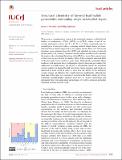Files in this item
Structural chemistry of layered lead halide perovskites containing single octahedral layers
Item metadata
| dc.contributor.author | McNulty, Jason A. | |
| dc.contributor.author | Lightfoot, Philip | |
| dc.date.accessioned | 2021-07-07T14:30:10Z | |
| dc.date.available | 2021-07-07T14:30:10Z | |
| dc.date.issued | 2021-07 | |
| dc.identifier | 274358694 | |
| dc.identifier | b9b6fa98-52c2-4029-9df1-e60492d19799 | |
| dc.identifier | 000670812900003 | |
| dc.identifier.citation | McNulty , J A & Lightfoot , P 2021 , ' Structural chemistry of layered lead halide perovskites containing single octahedral layers ' , International Union of Crystallography Journal (IUCrJ) , vol. 8 , no. 4 , pp. 485-513 . https://doi.org/10.1107/S2052252521005418 | en |
| dc.identifier.issn | 2052-2525 | |
| dc.identifier.uri | https://hdl.handle.net/10023/23482 | |
| dc.description | Funding: Leverhulme Trust (award No. RPG-2018-065). | en |
| dc.description.abstract | We present a comprehensive review of the structural chemistry of hybrid lead halides of stoichiometry APbX4, A2PbX4 or AAʹPbX4, where A and Aʹ are organic ammonium cations and X = Cl, Br or I. These compounds may be considered as layered perovskites, containing isolated, infinite layers of corner-sharing PbX4 octahedra separated by the organic species. We first extract over 250 crystal structures from the CCDC and classify them in terms of unit cell metrics and crystal symmetry. Symmetry mode analysis is then used to identify the nature of key structural distortions of the [PbX4]∞ layers. Two generic types of distortion are prevalent in this family: tilting of the octahedral units and shifts of the inorganic layers relative to each other. Although the octahedral tilting modes are well-known in the crystallography of purely inorganic perovskites, the additional layer shift modes are shown to enrich enormously the structural options available in layered hybrid perovskites. Some examples and trends are discussed in more detail in order to show how the nature of the interlayer organic species can influence the overall structural architecture, although the main aim of the paper is to encourage workers in the field to make use of the systematic crystallographic methods used here to further understand and rationalise their own compounds, and perhaps to be able to design-in particular structural features in future work. | |
| dc.format.extent | 2677745 | |
| dc.language.iso | eng | |
| dc.relation.ispartof | International Union of Crystallography Journal (IUCrJ) | en |
| dc.subject | Layered perovskites | en |
| dc.subject | Symmetry mode analysis | en |
| dc.subject | Hybrid materials | en |
| dc.subject | QD Chemistry | en |
| dc.subject.lcc | QD | en |
| dc.title | Structural chemistry of layered lead halide perovskites containing single octahedral layers | en |
| dc.type | Journal item | en |
| dc.contributor.institution | University of St Andrews. School of Chemistry | en |
| dc.contributor.institution | University of St Andrews. EaSTCHEM | en |
| dc.identifier.doi | 10.1107/S2052252521005418 | |
| dc.description.status | Peer reviewed | en |
This item appears in the following Collection(s)
Items in the St Andrews Research Repository are protected by copyright, with all rights reserved, unless otherwise indicated.

